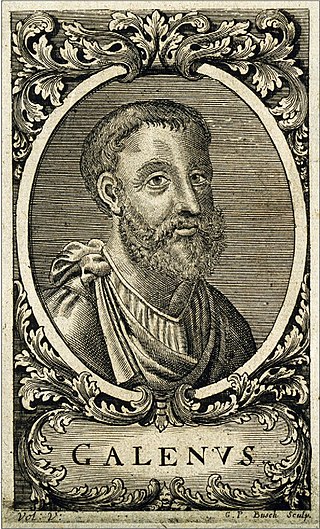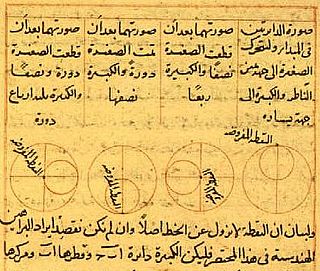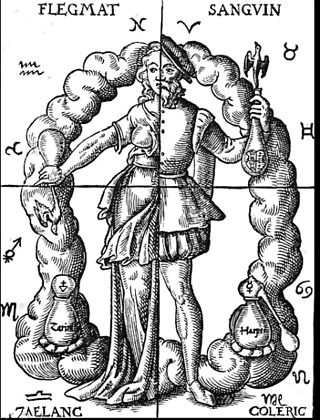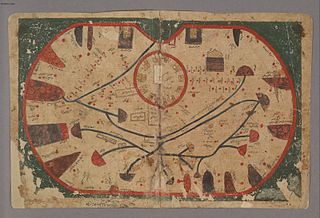Related Research Articles

Celestial globes show the apparent positions of the stars in the sky. They omit the Sun, Moon, and planets because the positions of these bodies vary relative to those of the stars, but the ecliptic, along which the Sun moves, is indicated.

Aelius Galenus or Claudius Galenus, often Anglicized as Galen or Galen of Pergamon, was a Greek physician, surgeon and philosopher with Roman citizenship. Considered to be one of the most accomplished of all medical researchers of antiquity, Galen influenced the development of various scientific disciplines, including anatomy, physiology, pathology, pharmacology, and neurology, as well as philosophy and logic.

The history of medicine is both a study of medicine throughout history as well as a multidisciplinary field of study that seeks to explore and understand medical practices, both past and present, throughout human societies.

Abū Bakr al-Rāzī, c. 864 or 865–925 or 935 CE, often known as (al-)Razi or by his Latin name Rhazes, also rendered Rhasis, was a Persian physician, philosopher and alchemist who lived during the Islamic Golden Age. He is widely regarded as one of the most important figures in the history of medicine, and also wrote on logic, astronomy and grammar. He is also known for his criticism of religion, especially with regard to the concepts of prophethood and revelation. However, the religio-philosophical aspects of his thought, which also included a belief in five "eternal principles", are only recorded by authors who were often hostile to him.
ʿIlm al-Kalām, usually foreshortened to Kalām and sometimes called "Islamic scholastic theology" or "speculative theology", is the philosophical study of Islamic doctrine ('aqa'id). It was born out of the need to establish and defend the tenets of the Islamic faith against the philosophical doubters. However, this picture has been increasingly questioned by scholarship that attempts to show that kalām was in fact a demonstrative rather than a dialectical science and was always intellectually creative.

Science in the medieval Islamic world was the science developed and practised during the Islamic Golden Age under the Umayyads of Córdoba, the Abbadids of Seville, the Samanids, the Ziyarids, the Buyids in Persia, the Abbasid Caliphate and beyond, spanning the period roughly between 786 and 1258. Islamic scientific achievements encompassed a wide range of subject areas, especially astronomy, mathematics, and medicine. Other subjects of scientific inquiry included alchemy and chemistry, botany and agronomy, geography and cartography, ophthalmology, pharmacology, physics, and zoology.

The Book of Fixed Stars is an astronomical text written by Abd al-Rahman al-Sufi (Azophi) around 964. Following the translation movement in the 9th century AD, the book was written in Arabic, the common language for scholars across the vast Islamic territories, although the author himself was Persian. It was an attempt to create a synthesis of the comprehensive star catalogue in Ptolemy’s Almagest with the indigenous Arabic astronomical traditions on the constellations. The original manuscript no longer survives as an autograph, however, the importance of tradition and the practice of diligence central to Islamic manuscript tradition have ensured the survival of the Book of Stars in later-made copies.

Humorism, the humoral theory, or humoralism, was a system of medicine detailing a supposed makeup and workings of the human body, adopted by Ancient Greek and Roman physicians and philosophers.

Hunayn ibn Ishaq al-Ibadi ( Arabic: أبو زيد حنين بن إسحاق العبادي; ʾAbū Zayd Ḥunayn ibn ʾIsḥāq al-ʿIbādī was an influential Nestorian Christian translator, scholar, physician, and scientist. During the apex of the Islamic Abbasid era, he worked with a group of translators, among whom were Abū 'Uthmān al-Dimashqi, Ibn Mūsā al-Nawbakhti, and Thābit ibn Qurra, to translate books of philosophy and classical Greek and Persian texts into Arabic and Syriac.

In the history of medicine, "Islamic medicine" is the science of medicine developed in the Middle East, and usually written in Arabic, the lingua franca of Islamic civilization.
This timeline of science and engineering in the Muslim world covers the time period from the eighth century AD to the introduction of European science to the Muslim world in the nineteenth century. All year dates are given according to the Gregorian calendar except where noted.
Tennis or Tinnīs was a medieval city in Egypt which no longer exists. It was most prosperous from the 9th century to the 11th century until its abandonment. It was located at 31°12′N 32°14′E, on an island in Lake Manzala, southwest of Port Said.

Abu'l Hassan Ali ibn Ridwan Al-Misri was an Arab of Egyptian origin who was a physician, astrologer and astronomer, born in Giza.
An ijazah is a license authorizing its holder to transmit a certain text or subject, which is issued by someone already possessing such authority. It is particularly associated with transmission of Islamic religious knowledge. The license usually implies that the student has acquired this knowledge from the issuer of the ijaza through first-hand oral instruction, although this requirement came to be relaxed over time. An ijaza providing a chain of authorized transmitters going back to the original author often accompanied texts of hadith, fiqh and tafsir; but also appeared in mystical, historical, and philological works, as well as literary collections. While the ijaza is primarily associated with Sunni Islam, the concept also appears in the hadith traditions of Twelver Shia.
The Graeco-Arabic translation movement was a large, well-funded, and sustained effort responsible for translating a significant volume of secular Greek texts into Arabic. The translation movement took place in Baghdad from the mid-eighth century to the late tenth century.

The Islamic Golden Age was a period of scientific, economic and cultural flourishing in the history of Islam, traditionally dated from the 8th century to the 13th century.
Sonja Brentjes is a German historian of science, historian of mathematics, and historian of cartography known for her work on mapmapking and mathematics in medieval Islam.

The Book of Curiosities is an anonymous 11th-century Arabic cosmography from Fatimid Egypt containing a series of early illustrated maps of the world and celestial diagrams of the universe and sky. TheBook of Curiosities contains 17 maps in total, 14 of which are extremely rare not only in Islamic cartography but also in greater medieval map history. The cosmography includes the earliest recorded map of Sicily as well as a rectangular world map, considered the earliest surviving map with a graphic scale. The autograph manuscript has not survived, but the Bodleian Library of Oxford University acquired one of the only known copies of the manuscript in 2002, making its contents widely accessible today due to its digitization. Based on the production processes and physical materials of the copy, such as paper and pigment, scholars date the production of this copy to the early 13th century.
Anna Ayşe Akasoy is a German orientalist and professor of Islamic intellectual history at the Graduate Center, CUNY. Akasoy works on the intellectual history of Islam, especially of al-Andalus, on Islamic philosophy as well as on Arab veterinary medicine, falconry and hunting.
Evelyn Edson is an author, medievalist, and professor emerita of history. She is known for her three books on the history of cartography.
References
- 1 2 3 Professor Emilie Savage-Smith FBA, British Academy, retrieved 2021-02-04
- 1 2 3 4 5 6 7 Curriculum vitae, University of Oxford, retrieved 2021-02-04
- ↑ WorldCat catalog entry for Galen on Nerves, Veins and Arteries, retrieved 2021-02-04
- ↑ About the Society, Society for the History of Medieval Technology and Science, retrieved 2021-02-04
- ↑ Reviews of Lost Maps of the Caliphs:
- Zayde Antrim (2019), Imago Mundi, doi:10.1080/03085694.2019.1607067
- Nicola Boothby (2019), Maps in History,
- Anna Caiozzo (2020), Cahiers de Recherches des Médiévales et Humanistes, doi:10.4000/crm.16294
- Susana Calvo Capilla and Azucena Hernández Pérez (2020), Anales de Historia del Arte, doi:10.5209/anha.72191
- Sarah Davis-Secord (2020), Bulletin of the School of Oriental and African Studies, doi:10.1017/S0041977X20000130
- Jean-Charles Ducène (2020), Medieval Encounters, doi:10.1163/15700674-12340068
- Kyle T. Evered (2019), Historical Geography, doi:10.1353/hgo.2019.0007
- Barbara Harrison (2020), Cartographic Perspectives, doi:10.14714/cp95.1621
- Benjamin B. Olshin (2020), Terrae Incognitae, doi:10.1080/00822884.2020.1847913
- Sameer Rahim (2019), Apollo,
- Daniel Martin Varisco (2020), Peregrinations,
- ↑ Reviews of Medieval Islamic Medicine:
- Anna Akasoy (2007), Asian Medicine, doi:10.1163/157342008X307947
- Guy Attewell (2009), Annals of Science, doi:10.1080/00033790802136447
- Hinrich Biesterfeldt (2009), Die Welt des Islams, JSTOR 27798293
- Charles Burnett (2009), Journal of Islamic Studies, JSTOR 26200613
- Emilia Calvo (2008), Suheyl,
- Nils Fischer (2008), Sudhoffs Archiv, JSTOR 20778371
- Ivan Garofalo (2008), Gesnerus, doi:10.1163/22977953-0650102022
- Ingrid Hehmeyer (2007), Isis, doi:10.1086/529291, JSTOR 10.1086/529291
- Abdul Nasser Kaadan (2011), Journal of the Medieval Mediterranean, doi:10.1080/09503110.2011.580637
- Oliver Kahl (2008), Bulletin of the History of Medicine, JSTOR 44448620
- Carsten Schliwski (2009), Zeitschrift der Deutschen Morgenländischen Gesellschaft, JSTOR 10.13173/zeitdeutmorggese.159.2.0444
- Daniel Martin Varisco (2008), American Journal of Islamic Social Sciences, doi:10.35632/ajis.v25i3.1462
- M. K. K. Yearl (2008), Journal of the History of Medicine and Allied Sciences, JSTOR 24631868
- ↑ Reviews of Medieval Views of the Cosmos:
- Bruce Eastwood (2007), International Journal of the Classical Tradition, JSTOR 30222166
- Mónica Herrera-Casais (2007), Suheyl,
- Robert Hoyland (2005), The Medieval Review,
- Naomi Reed Kline (2006), Speculum, doi:10.1017/S0038713400015992
- ↑ Reviews of Islamicate Celestial Globes:
- Donald R. Hill (1988), Technology and Culture, doi:10.2307/3105292, JSTOR 3105292
- David A. King (1990), Isis, JSTOR 233847
- Paul Kunitzsch (1988), Journal for the History of Astronomy, doi:10.1177/002182868801900408
- Mara Miniati (1987), Nuncius, doi:10.1163/182539177X01097
- ↑ Reviews of Islamic Geomancy and a Thirteenth-Century Divinatory Device:
- Herbert Eisenstein (1983), Wiener Zeitschrift für die Kunde des Morgenlandes, JSTOR 23868601
- Josef van Ess (1982), Die Welt des Orients, doi:10.2307/1569826, JSTOR 1569826
- Bernard R. Goldstein (1981), Isis, JSTOR 230295
- David A. King (1982), Archaeoastronomy, Bibcode:1982Arch....5a..42K,
- Paul Kunitzsch (1983), Die Welt des Orients, JSTOR 25683121
- ↑ 506 receive DePauw degrees at university's 175th commencement, DePauw University, 18 May 2014, retrieved 2021-02-04
- ↑ Annual invitation (medal) meetings, Scientific Instrument Society, retrieved 2021-02-04
- ↑ Health, Magic and Stars: Workshop on the history of Islamic science in Honour of Emilie Savage-Smith, St Cross, Oxford, 29 March 2019, H-net , retrieved 2021-02-04
- ↑ "Pre-2010", British-Kuwait Friendship Society Book Prize, retrieved 2021-02-04